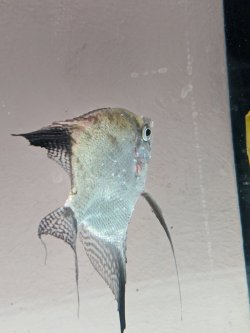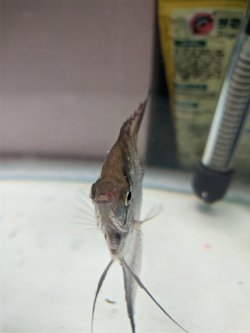It's either excess mucous caused by something in the water stressing them out, or hexamita (hole in the head). I'm going with mucous at this stage.
The fish also has a sinus infection (red around the nose and face).
----------------------
Anti-biotics should only be used on known bacterial infections that have not responded to normal fish medications/ treatments. Improper use and mis-use of anti-biotics has lead to drug resistant bacteria that kill people, birds, animals, reptiles and fish.
In future, please try to identify issues before using medications because many chemicals cause long term health issues to fish, including weakening their immune system.
----------------------
You want to keep nitrates as close to 0ppm as possible and under 20ppm at all times. The easiest way to do this is by doing bigger water changes more often.
----------------------
Wipe the inside of the glass down with a clean fish sponge.
Do a 75% water change and gravel clean the substrate every day for a week, then do it once a week after that. The water changes and gravel cleaning will reduce the number of disease organisms in the water and provide a cleaner environment for the fish to recover in.
Make sure any new water is free of chlorine/ chloramine before it is added to the tank.
Clean the filter if it hasn't been done in the last 2 weeks. Wash the filter materials/ media in a bucket of tank water and re-use them. Tip the bucket of dirty water on the garden/ lawn.
Increase surface turbulence/ aeration when using medications because they reduce the dissolved oxygen in the water.
Add salt, (see directions below).
----------------------
SALT
You can add rock salt (often sold as aquarium salt), sea salt or swimming pool salt to the aquarium at the dose rate of 2 heaped tablespoon per 20 litres of water.
If you only have livebearers (guppies, platies, swordtails, mollies), goldfish or rainbowfish in the tank you can double that dose rate, so you would add 4 heaped tablespoons per 20 litres.
Keep the salt level like this for at least 2 weeks but no longer than 4 weeks otherwise kidney damage can occur. Kidney damage is more likely to occur in fish from soft water (tetras, Corydoras, angelfish, gouramis, loaches) that are exposed to high levels of salt for an extended period of time, and is not an issue with livebearers, rainbowfish or other salt tolerant species.
The salt will not affect the beneficial filter bacteria but the higher dose rate (4 heaped tablespoons per 20 litres) will affect some plants and some snails. The lower dose rate will not affect plants, shrimp or snails.
After you use salt and the fish have recovered, you do a 10% water change each day for a week using only fresh water that has been dechlorinated. Then do a 20% water change each day for a week. Then you can do bigger water changes after that. This dilutes the salt out of the tank slowly so it doesn't harm the fish.
If you do water changes while using salt, you need to treat the new water with salt before adding it to the tank. This will keep the salt level stable in the tank and minimise stress on the fish.
----------------------
If there's no improvement after a week of daily water changes and salt, post more pictures of the angelfish and the other fish in the tank so we can check them for diseases.




